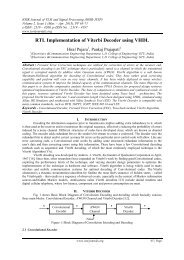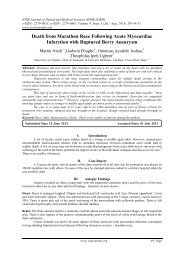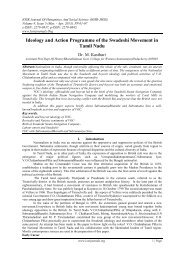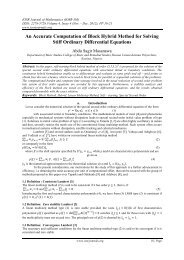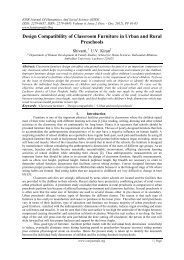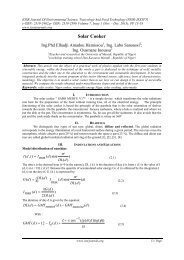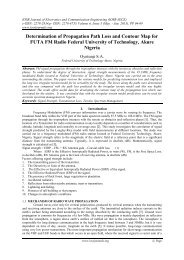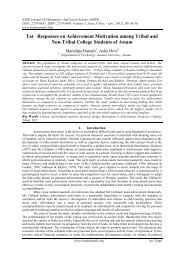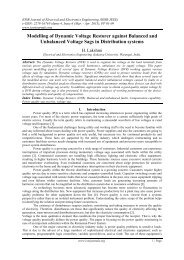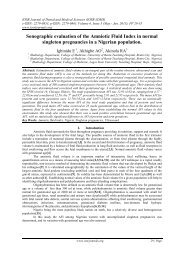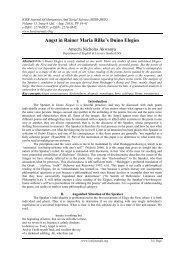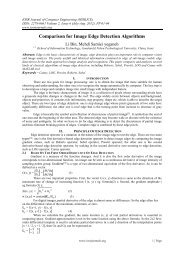Full PDF - IOSR
Full PDF - IOSR
Full PDF - IOSR
You also want an ePaper? Increase the reach of your titles
YUMPU automatically turns print PDFs into web optimized ePapers that Google loves.
Behaviour of Eccentrically Loaded Model Square Footing on Reinforced Soil: An Experimental Investigation<br />
The review, further, highlights relatively lesser work on reinforced soil technique using rubbergrids as<br />
reinforcing material in solving engineering problems associated with foundations on soft clays subjected to<br />
vertical centric and eccentric loads. On the backdrop of the need to understand the behaviour of rubber<br />
reinforced system, an experimental investigation was conducted on the model footings reinforced with<br />
rubbergrid, Dewaikar et al. [15] reported the study of load deflection behaviour of model square and circular<br />
footings, under un-reinforced and reinforced conditions in respect of a two-layered system, consisting of clay as<br />
sub-grade and mine waste as backfill material, under the application of vertical centric loads.<br />
Kolon geogrid KGR-40, non woven geotextile GPB-203 (Sri Dinesh Mills, Vadodara) and rubbergrids<br />
derived out of waste tyres (Fig. 1) were used as single layer reinforcements soft sub-grade to control settlement<br />
were investigated in the studies. The width and depth of the reinforcing materials were varied to determine their<br />
effects on the settlement and bearing capacity ratios. The results on rubber grids showed that, there is significant<br />
difference in the contribution of increase in bearing capacity ratios and settlement reduction factors as compared<br />
to the other reinforcing elements.<br />
Along similar lines, The load-deformation behavior of a model square footing under un-reinforced and<br />
reinforced conditions in respect of a two-layered system, consisting of clay as sub-grade and mine waste as<br />
backfill material, under the application of eccentric loads along one axis of the footing is reported in this paper.<br />
In view of this, an experimental investigation was conducted on the soft soil reinforced with geotextiles, geogrid<br />
and rubber grid.<br />
III. MATERIALS AND METHODOLOGY OF INVESTIGATION<br />
Experimental Programme<br />
The experimental programme included a series of model footing tests on two layered soil system. Model mild<br />
steel plates of square and circular shapes with thickness 20 mm were used and following aspects were studied.<br />
• Shape of footing: Square (120 mm × 120 mm)<br />
• Eccentricity of the applied load (e): 0.00B, 0.1 B, 0.2 B and 0.3 B (B being the width / diameter of<br />
model footing)<br />
• Thickness of the granular layer (H): 0.25 B, 0.375 B and 0.5 B<br />
• Width of the reinforcement (B’): 2 B, 4 B and 6B<br />
• Type of reinforcement: Geotextile, Geo-grid and Rubber-grid (Fig.1)<br />
Geotextile Geogrid Rubbergrid<br />
Fig. 1: Different reinforcement used in the study<br />
Test Tank Details<br />
Tests were conducted in a tank (1000 mm × 1000 mm × 1000 mm) fabricated out of 8 mm thick M.S. plates.<br />
Load was applied through a load cell of 50 kN capacity, attached to a hydraulic jack and it was operated through<br />
a hydraulic power pack of 75 kN capacity. A load and displacement indicator unit facilitated reading the applied<br />
load and displacement of footing at any instant of time to an accuracy of 10 N. Three linear variable differential<br />
transformers (LVDT) were used to record settlements of the footing (Fig.2). The model footings (120×120×20<br />
mm) were placed on air-dried (un-reinforced and reinforced) mine waste, compacted to a relative density of<br />
78.85% on clay sub-grade of wet density 1.768 gm/cc with 88% degree of saturation. Footings were subjected to<br />
vertical eccentric loads.<br />
The schematic of the model footings (cross-section and plan) is shown in Fig.2. The physical properties<br />
of soils are reported in Table 1 and 2. The description and properties of the reinforcements are reported in Table<br />
3 -5.<br />
Second International Conference on Emerging Trends in Engineering (SICETE)<br />
Dr.J.J.Magdum College of Engineering, Jaysingpur<br />
53 | Page



